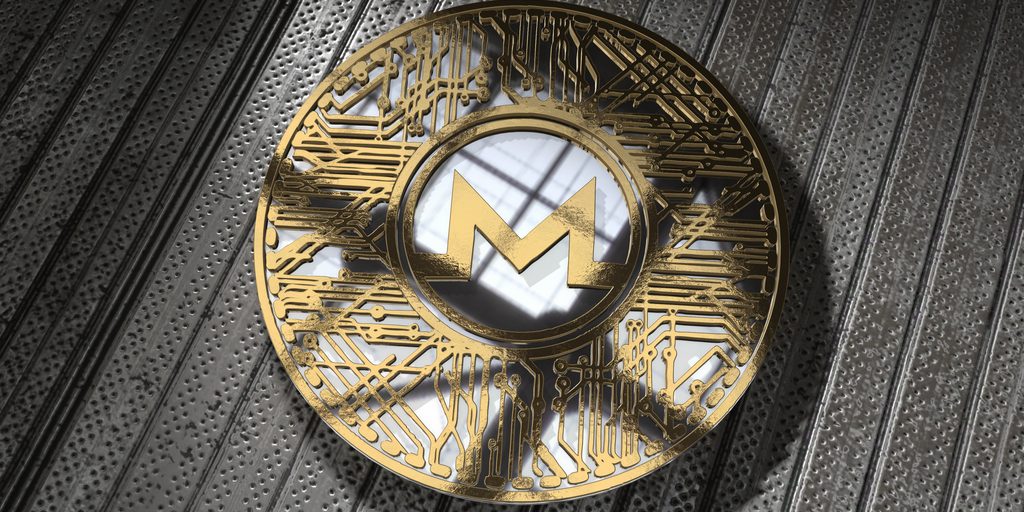What is Monero? Information about one of the most private cryptocurrencies on the market
The blockchain technology has offered immense advantages for financial transactions. The speed with which these transactions can theoretically be executed is very fast, the effectiveness is high and the security can compare to those of established financial institutions. Another feature that has been cited as an advantage is the openness and transparency offered by the technology. The distributed ledgers, which record transactions on the network, are owned by every participant of the network. As a result, everyone is able to observe the transactions going on in the network. While this is often considered a great asset of the emerging technology, some could think it disadvantageous. With financial transactions, some users value privacy more. If it is possible for third parties to trace the origin, destination and amount of each transaction, user data can be compromised, which would inconvenience the users. With each issue and need there’s to be an answer in some cryptocurrency. In this case that cryptocurrency would be Monero. To really see what Monero is and how it creates privacy in the system, it is important to look at its origin story and see its technical features. What Monero does, could answer a lot of questions regarding cryptocurrencies in general.
Monero is an open-source cryptocurrency which can be run on Windows as well as MacOS, Linux, Android and FreeBSD. At first sight, there isn’t much of a difference between some of the traditional cryptocurrencies like Bitcoin and Monero. If the latter is inspected more closely, it is evident that the true definition of Monero lies in the emphasis the network puts on issues like privacy and scalability. Primarily, it targets the issues of privacy. How it achieves this will be discussed in more detail later. Nevertheless, it should be noted that enhancing user privacy and making it more difficult to trace transactions can be detrimental to the network as it also increases the appeal of the platform for illicit use such as money laundering. Cryptocurrencies have already been criticized for facilitating illicit activities and increased privacy will only exacerbate the problem. This has been the case for Monero as well, although it is also a great tool for legitimate transactions by users that simply prefer to be more private with their financial activities.

History and background of Monero explained
The creation of Monero follows an interesting story that began with an unidentified Bitcointalk user named thankful_for_today forking the codebase of Bytecoin in 2014 to create BitMonero. The name was made up of two parts. The first part, Bit, has obvious associations with Bitcoin and the second part Monero, which would later become the name of the platform means coin in Esperanto, a constructed international auxiliary language. So, if anyone wondered what Monero stands for, it simply means coin. BitMonero wasn’t received by the community with open arms and thankful_for_today didn’t continue to improve on its deficiencies, instead, the network participants took over the project. The users changed the name to Monero as well. At those stages, the group was already focusing on privacy issues, which led to the explosion of the cryptocurrency. There was an obvious demand for a platform with enhanced privacy features. In fact, Monero had one of the biggest growth rates among cryptocurrencies in 2016.
Unfortunately, the demand for Monero wasn’t driven solely by legitimate users. As more people found out what Monero is, more users of the darknet market started to pay for stolen credit cards, drugs, guns and more illegal products using Monero coins. Another way people used Monero was to break links in transaction chains. For example, if they wanted to pay someone using Bitcoin but wanted to do so privately, they would convert their holdings to Monero, then convert it back to Bitcoin and use the funds. The network itself was constantly developing and enhancing its features. For example, at the beginning of 2017, it adopted the Confidential Transactions algorithm developed by Gregory Maxwell, that allowed it to hide the amounts of transactions as well.
The cryptocurrency started to become increasingly more controversial as the events started to unfold. First, the white nationalists like Christopher Cantwell and Andrew Auernheimer started to promote the cryptocurrency after some of the online payment platforms denied them access to their services. This obviously attracted negative attention to Monero. Later in 2017, hackers used Monero to hide the funds during the WannaCry ransomware incident. In 2018, a statistic shows Monero being used in almost half of all cryptocurrency ransomware attacks. This shows the negative side of privacy clearly and has also drawn criticism from many people to the Monero network.

Technical features of Monero explained simply
To explain Monero, it is necessary to go into a little more detail about its technical specifications. Monero is based on the CryptoNote protocol which differentiates it from the other blockchain platforms that derive from Bitcoin. CryptoNote enables the encryption of transactions. Using the principle of ring signature, the network allows any member of a closed group to leave the electronic signature without anyone knowing who did so. In addition, because of the privacy in the network, Monero coins are fungible, which means that they can be substituted for each other. While on other networks each address is associated with a specific activity and the actions of the address can be traced it is not the same for Monero. Moneros are virtually indistinguishable. Furthermore, for each transaction made on the network, there is an individual “stealth address” generated, which makes it impossible for anyone to trace the destination of the transactions. The amount of the transaction is hidden with the “ring confidential transactions” mechanism. The source of the transaction is hidden with ring signatures. Thus, in total, Monero enables privacy on the network in three different ways. It hides the source of the transaction, the destination of the transaction and the amount transferred.
While other major cryptocurrency networks like Bitcoin enable full transparency, Monero offers private transactions, but that doesn’t mean that the users who want to transact openly don’t have an option to do so. What Monero does for such users is that it offers what’s known as optional transparency. Each address has two sets of keys, one is a view key and the other is a spend key. If users want to transact openly, they can simply share the view key with the others.
How is Monero mined?
Another big part of how Monero is defined is the mining. Mining is one of the most important features of the cryptocurrencies. It is often what incentivizes the adoption of the currency. It also defines the supply of the currency and consequently affects its price in the long-term. Monero uses the principle of Proof-of-work for mining its currency. The miners in the network aim to solve a certain ‘puzzle’ in order to be able to claim a reward in the form of newly mined cryptocurrency. While doing so, the miners also validate the transactions on the network and add a new block to the blockchain. Generation of a new block happens every two minutes. The same number for Bitcoin network is ten minutes. The short period for generating blocks is important for merchants who want the transactions to be validated in a short period of time. More blocks that have been added to the blockchain after a specific transaction, the higher the chances that the transaction will not be reversed.

For many cryptocurrency platforms that use the Proof-of-work protocol, the supply of the coins is capped. This means that after a certain period of time has passed, there won’t be any more coins generated. This has been a cause for concern for many network participants in platforms like Bitcoin. As there won’t be new coins generated the incentives for miners will be lower and without miners, there’s no one to validate the transactions. Of course, the miners will still be able to collect the transaction fees, but they might require higher fees to compensate for the absence of rewards. Monero differs from Bitcoin in this aspect. After the network mines 18.4 million coins, which is expected to happen by 2022, the bocks that will be added to the chain afterward will earn the miners 0.6 new coins. This way, an incentive to participate in the mining process still remains.
Mining Monero is not a difficult task in terms of the mining hardware. The network participants can even use CPUs to mine Monero, which is not possible for some major cryptocurrencies that have been taken over by advanced specifically targeted mining hardware, which makes the CPUs obsolete.
Monero – explanation of the advantages
The first obvious advantage of the Monero platform is privacy. This is the distinguishing factor that has fuelled the demand for the cryptocurrency and it is what Monero stands for. It could also represent the biggest threat to the network as the privacy attracts illicit activity, but for now, privacy remains the biggest selling point for Monero. “Being a great feature, untreaceability doesn’t protect a receiver from defining his or her balance through inspecting ingoing messages to the user’s public address. Therefore, Monero employs a specific protocol which generates multiple unique one-time addresses that can only be linked by the payment receiver and are unfeasible to be revealed through blockhain analysis,” – reads monero.org website. Security is another issue that is extremely important for cryptocurrencies. We hear about hackers getting away with stolen coins too often. Monero characterizes its wallet as unbreakable because of the immense computational power a hacker would need to breach the security measures.
In addition to these features, Monero is also Analysis Resistant. “Monero’s blockhain analysis resistance results from unlinkability, which was achieved by using a modified version of the Diffie-Hellman exchange protocol that generates multiple one-time public addresses that can only be simply gathered by the message receiver, but hardly analyzed by confused foreigners inside the block explorer.is,” – states the website. This is important for people who don’t want their data to be analyzed statistically because of additional privacy concerns.

Price and market capitalization of Monero explained in detail
As Monero was introduced in 2014, years before the whole cryptocurrency market crossed over into the mainstream, it had a few years of relatively smaller fluctuations. The price of the coin changed between $0.2 and $1.2 for the most part going lower and higher for short periods of time. By 2017, the price stood at just over $10. Then, as the cryptocurrency market was hit by a wave of extremely large growth, Monero price skyrocketed as well. In a matter of months, the price of the asset reached over $460. If at the launch of the platform the market capitalization of the coin was just over $2 million, at its peak, it reached over $7 billion. This was an immense growth that would be unrealistic for any other type of asset. In 2018, the price of cryptocurrencies, in general, started to deflate and Monero wasn’t an exception either. By November 2018, the price had gone down to $55 and the market capitalization stood at just under $1 billion. While still a significant increase from a year earlier, a sevenfold decrease in the valuation was bound to shake up the investor confidence. As of November 2018, Monero is the ninth biggest cryptocurrency in the world, behind Litecoin and above Cardano.
In conclusion, the main differentiating feature of Monero is the privacy that it offers. To the question ‘what does Monero do?’ the answer is simple. Monero is able to conceal the source of the transaction as well as its destination and the amount transferred. While this offers some clear advantages to users who simply prefer to transact privately, it is also a great tool for illicit activities, money laundering and payments in the dark web. All of these activities together have driven up the price and market capitalization of the coin to see a 3,500x gain since the introduction. Nevertheless, it has also earned the platform criticism from people who see cryptocurrencies as a threat to the financial stability and law enforcement.


























Comments (0 comment(s))